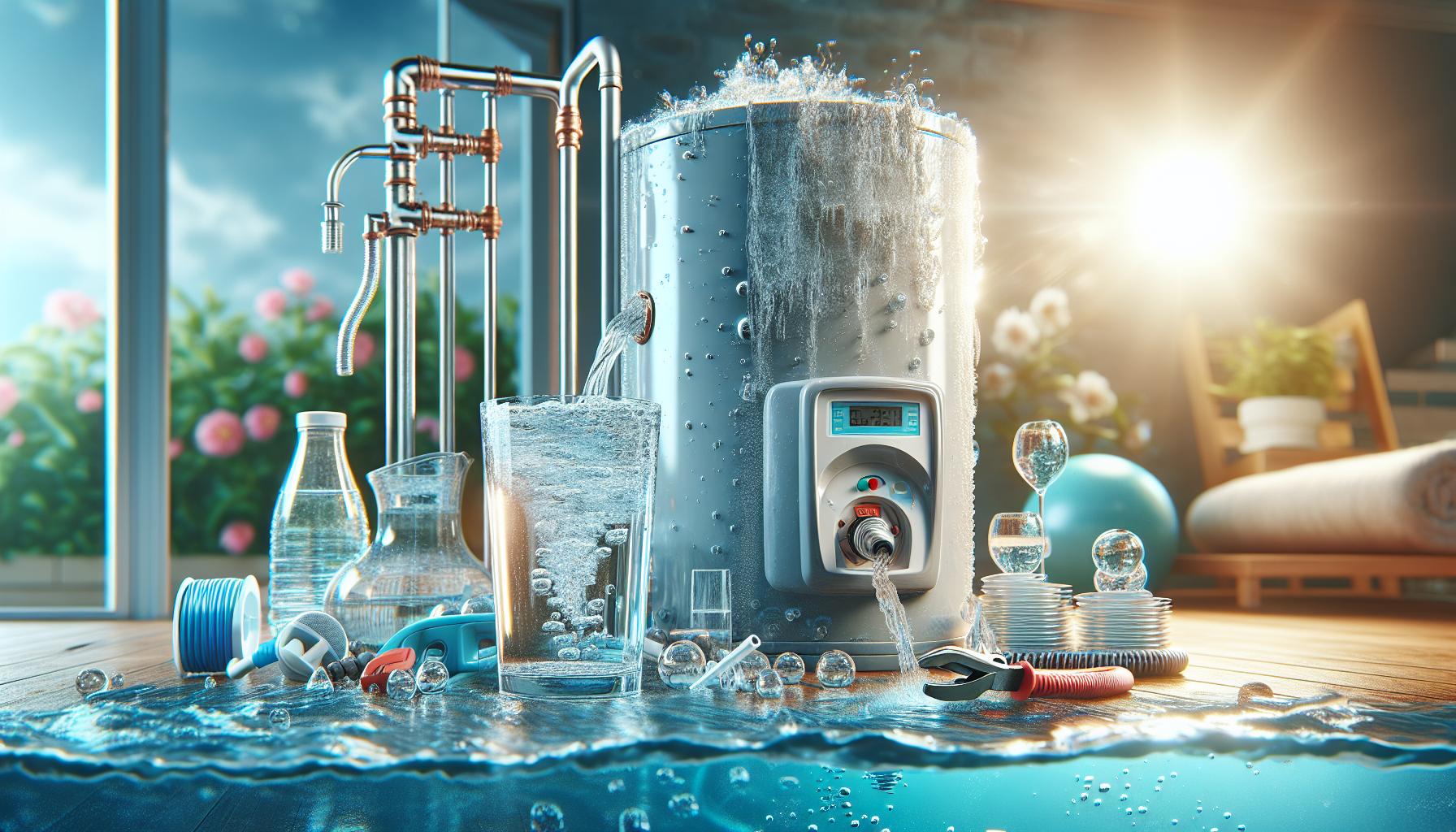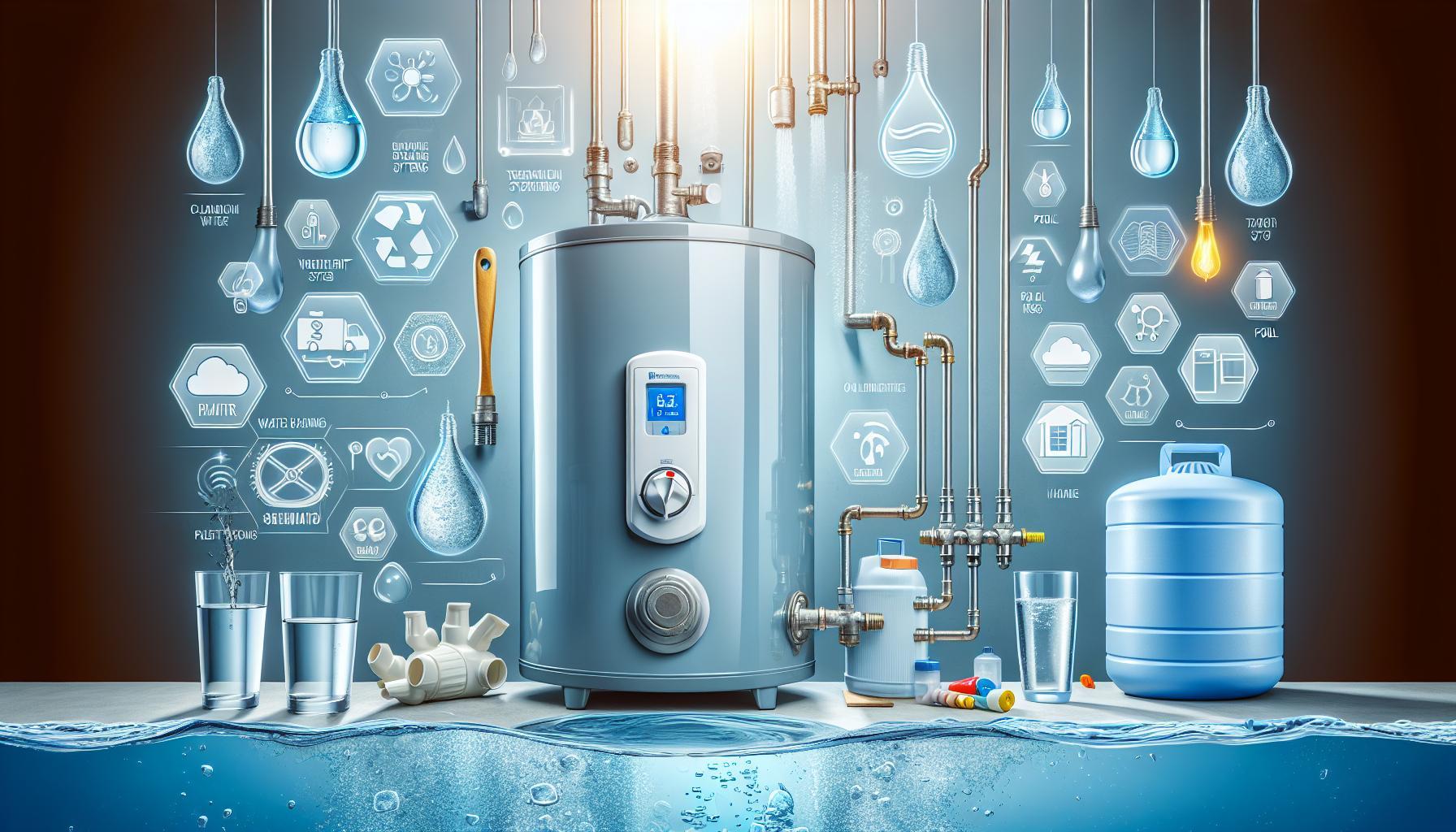When it comes to maintaining your home’s hot water system, knowing how long it takes to drain a 50-gallon water heater can save you time and frustration. Generally, this process takes about 30 minutes to 1 hour, making it essential to plan accordingly. Regular maintenance not only ensures efficient performance but also prolongs the life of your heater, keeping your hot water flowing smoothly.
Understanding the Importance of Regular Water Heater Maintenance
Regular maintenance for your water heater can be a game-changer, extending its lifespan and optimizing its efficiency. Just like any other essential home appliance, neglecting your water heater can lead to significant issues, including unexpected breakdowns, fluctuating water temperatures, and even costly repairs. Performing routine maintenance ensures that your unit runs smoothly and helps you avoid the headaches associated with emergency repairs, particularly in a busy household where hot water is crucial.
One key aspect of maintaining your water heater is understanding the process of draining it periodically. Regularly draining your water heater not only removes sediment buildup but also improves hot water efficiency. When sediment accumulates at the bottom of the tank, it can create a barrier that slows down heating efficiency, leading to longer wait times for hot water. This is particularly vital for a 50-gallon unit, where the draining process can significantly impact overall performance. According to our guide, knowing how long to drain a 50-gallon water heater and executing the task correctly can enhance its performance and life expectancy.
To undertake this maintenance task, follow these steps:
- Turn Off the Heater: For electric units, ensure the power supply is disconnected.
- Attach a Hose: Connect a garden hose to the drain valve, positioning it towards a suitable drainage area.
- Open the Valve: Allow the tank to drain fully. This step typically takes around 20-30 minutes for a 50-gallon tank, depending on your water pressure.
- Flush the Tank: Once drained, briefly turn on the cold water supply to stir up remaining sediment before fully draining again.
By incorporating this simple yet effective maintenance practice, homeowners can drastically reduce the chances of unplanned breakdowns and ensure that their water heaters consistently provide reliable hot water. Regular maintenance, such as what is described in the article on how long to drain a 50-gallon water heater, not only promotes energy efficiency but also enhances comfort and convenience in daily activities.
Preparing Your Space: Tools and Safety Measures Before Draining
When preparing to drain your water heater, particularly a 50-gallon unit, ensuring that your workspace is ready is crucial for a safe and efficient process. Draining a water heater not only requires the right tools but also a commitment to safety measures that can prevent accidents and complications. By taking the time to prepare your space properly, you’ll be able to execute the task with confidence and ease.
Essential Tools
Before you begin, gather the necessary tools to make the draining process smooth. Here’s a quick list of what you will need:
- Bucket or Hose: A bucket can hold a significant amount of water, while a hose can direct water to a safe drainage location.
- Screwdriver: This will be needed to open any access panels and for the drain valve.
- Wrench: Useful for tightening connections if necessary.
- Towel or Rag: To wipe up any spills or drips during the process.
- Safety Goggles and Gloves: Protect your eyes and hands from hot water and debris.
Safety Measures
Taking safety precautions is non-negotiable when undertaking maintenance. Start by ensuring that your water heater is turned off, especially the gas supply if applicable. Once the heater is off, allow the water to cool down to avoid burns. This might take several hours, but patience here will pay off later.
Also, check the area around your water heater for anything that could obstruct your work or become a hazardous slip. Clear out any debris and ensure proper ventilation if you are working with a gas water heater, as well-maintained ventilation prevents harmful gas accumulation. Remember to have a phone handy to call for help in case of an emergency.
Extra Precautions
If your water heater is installed in a tighter space, consider laying down some towels or a waterproof tarp to catch spills. It’s wise to inform others in your household of your activities. An unexpected shock from someone turning on a nearby faucet while you’re draining can lead to complications or accidents.
With the right tools and safety measures in place, you are now equipped to tackle the draining process effectively. Following the guidelines outlined in this article will not only streamline draining your 50-gallon water heater but also ensure that you do so in a safe environment, ready to move on to the steps outlined in the comprehensive guide.
Step-by-Step Instructions for Draining Your 50 Gallon Water Heater
Before starting the draining process of your 50-gallon water heater, it’s essential to understand that regular maintenance can significantly enhance the longevity of your unit. Over time, sediment builds up at the bottom of the tank, which can hinder performance and potentially lead to costly repairs. The process of draining and flushing your water heater may take a bit of time, but following these step-by-step instructions ensures that your system functions efficiently and reduces energy costs.
Preparation Steps
Before you begin, gather the necessary tools: a garden hose, a bucket (to catch any excess water), and a wrench. Follow these preparatory steps:
- Turn Off Power: For electric heaters, switch off the power at the circuit breaker. For gas heaters, set the thermostat to the ‘pilot’ setting.
- Shut Off the Cold Water Supply: Locate the cold water supply valve on top of the heater and turn it clockwise to close it.
- Connect a Hose: Attach a garden hose to the drain valve located at the bottom of the tank. Run the hose to a suitable drainage location, such as a floor drain or outside.
Draining the Water Heater
Once you’re prepared, it’s time to start the draining process. Follow these steps:
- Open the Drain Valve: Using a wrench, carefully open the drain valve to allow water to flow out. You should see water start to exit through the hose.
- Open the Hot Water Faucet: To prevent a vacuum from forming, open a nearby hot water faucet. This will allow air into the system and help the water drain more smoothly.
- Flush the Tank: Once the tank is empty, it’s good practice to flush it out. To do this, briefly open the cold water supply valve while the drain valve is still open. This helps stir up any remaining sediment and pushes it out of the tank.
Finishing Up
After draining and flushing, it’s time to wrap things up:
- Close the Drain Valve: Once the tank is flushed and drained, close the drain valve securely.
- Remove the Hose: Carefully detach the garden hose from the drain valve.
- Refill the Tank: Open the cold water supply valve to refill the tank. Keep the hot water faucet open until a steady stream of water flows, indicating the tank is full and air is purged.
- Restore Power: Finally, turn the water heater’s power back on at the breaker for electric units, or reset the thermostat for gas units.
By following this comprehensive guide on how to drain and flush a 50-gallon water heater, you can ensure your system remains in top condition, efficiently delivering hot water for your needs. Regular maintenance not only extends the life of your unit but also improves its efficiency, helping you save on energy costs.
How to Identify and Address Sediment Buildup in Your Heater
Detecting sediment buildup in your water heater can prevent costly repairs and ensure efficient operation. Sediment consists primarily of minerals and debris collected from the water supply, which can accumulate at the bottom of the tank, decreasing the heater’s ability to function properly. If neglected, this accumulation can lead to reduced efficiency, increased energy costs, and even system failure. Regular checks and maintenance can help maintain optimal performance.
To identify sediment buildup, look for several warning signs. First, if you hear unusual popping or rumbling noises coming from the heater, this could indicate that sediment is heating and cooling within the tank. Additionally, cloudy or discolored hot water is a significant indicator that sediment may be present. Lastly, if you’re experiencing inconsistent water temperatures or a noticeable decrease in hot water availability, it may be time to inspect your heater for sediment. Performing regular maintenance, including flushing out the tank, can help prevent these issues from developing.
Steps to Address Sediment Buildup
Addressing sediment buildup involves a few straightforward steps. Here’s how to get started:
- Preparation: Turn off the water heater and disconnect the power source. For electric units, ensure the breaker is switched off; for gas units, set the thermostat to “pilot.”
- Connect a Hose: Attach a garden hose to the drain valve located at the bottom of the water heater.
- Drain the Tank: Open the drain valve and let the water run out until clear water flows from the hose. This may take some time, especially in larger tanks like a 50-gallon unit.
- Flush the Tank: To remove remaining sediment, you can briefly turn on the cold water supply to help flush debris out. Allow the water to run until it appears clear.
- Reconnect and Refill: Once drained and flushed, close the drain valve, remove the hose, and refill the tank by turning on the cold water supply. Finally, restore power to the water heater.
By following these steps, you can effectively address sediment buildup and maintain your water heater’s efficiency. Regular maintenance, ideally every six to twelve months, not only improves water quality but also extends your heater’s lifespan, leading to significant long-term savings [[1](https://thompsonplumbingco.com/is-sediment-in-hot-water-heater-dangerous-find-out-here/)][[2](https://theplumbero.com/how-to-flush-sediment-out-of-water-heater/)].
Timing It Right: How Long Does the Draining Process Typically Take?
Draining a water heater is an essential maintenance task that many homeowners overlook until they notice problems. If you’ve ever wondered how long this process takes, you’re not alone. The time required to drain a water heater depends on several factors, including the tank’s size, sediment build-up, and water pressure. For a standard 50-gallon water heater, the draining process can typically take anywhere from 20 to 30 minutes, though it may extend to an hour or more under certain conditions.
Understanding the factors that contribute to draining time can help you plan this task more effectively. Before you start, consider the following variables:
- Size of the Tank: Larger tanks will naturally take longer to empty.
- Water Pressure: Higher water pressure can expedite the draining process.
- Sediment Buildup: Too much sediment can slow the flow and increase draining time.
- Draining Setup: Ensure your drainage hose is positioned correctly to avoid blockages.
You can optimize the draining experience by following a few practical steps. First, ensure the cold water supply valve is closed and a hot water tap is opened elsewhere in the home. This step prevents a vacuum that can slow the drain. Next, attach a garden hose to the drain valve, and direct it to a suitable drainage area. By allowing the tank to empty completely and ensuring no residual water remains, you promote better maintenance practices that can lead to improved efficiency and longer water heater lifespan.
To summarize, while draining a 50-gallon water heater may take about 20 to 30 minutes on average, it’s wise to set aside additional time to account for any unforeseen delays. Proper planning not only minimizes hassle but also maximizes the effectiveness of your water heater maintenance routine.
Tips for Efficiently Refilling and Restarting Your Water Heater
When it comes to maintaining a reliable hot water supply, mastering the process of refilling and restarting your water heater is essential. After draining a water heater, especially a 50-gallon unit, it’s crucial to ensure that the system operates efficiently once it’s refilled. A few simple yet effective steps can significantly enhance the performance of your water heater, extending its life and ensuring a steady flow of hot water when you need it.
Steps for Refilling Your Water Heater
Before you initiate the refilling process, double-check that the drain valve is securely closed. During draining, sediment can accumulate and cause blockages, so ensure you have cleaned it adequately. To start refilling, follow these steps:
- Turn on the cold water supply to the water heater; this will begin filling the tank.
- Open a hot water faucet in your home to allow air to escape from the system. This reduces pressure build-up, aiding in the smooth flow of water.
- Monitor the water supply until it flows steadily from the faucet, indicating that the tank is full.
Once the water heater is filled, it’s time to restart the system.
Restarting Your Water Heater
With the tank full, you’ll need to switch the power back on or ignite the pilot light, depending on whether you have an electric or gas water heater. Here are the steps:
- For electric units: Go to the circuit breaker and flip the switch back to the ‘On’ position. This activates the heating elements.
- For gas units: Locate the gas control valve and turn it to the “Pilot” position. Light the pilot according to the manufacturer’s instructions, then set the control valve to the “On” position.
After restarting, allow the heater some time—typically 30 minutes to an hour—to heat the water fully. During this period, check for leaks around the tank and connections, ensuring everything remains watertight.
Final Tips for Efficiency
To keep your water heater running optimally, consider scheduling regular maintenance checks and sediment flushes at least once a year. Additionally, insulating pipes and the water heater itself can reduce heat loss, enhancing efficiency. You might also want to investigate installing a thermostat set to 120°F to save energy without sacrificing comfort.
By following these steps and tips, not only can you efficiently refill and restart your water heater, but you can also maximize its longevity and efficiency. For more detailed guidance, refer to resources such as the article titled *How Long to Drain a 50 Gallon Water Heater? Step-by-Step Guide*.
Common Pitfalls to Avoid When Draining Your Water Heater
Draining a water heater can seem like a straightforward task, but there are several pitfalls that can turn it into a frustrating experience. For those wondering how long to drain a 50-gallon water heater, the process can take longer than expected if the proper precautions aren’t taken. Avoiding common mistakes can save you time, prevent damage, and ensure that your water heater continues to function efficiently.
- Neglecting a Safe Drainage Location: Always ensure that the drainage hose leads to a suitable, safe location. Avoid directing the water into areas that can be damaged by heat or moisture, such as near electrical outlets or appliances.
- Not Checking the Thermostat Setting: Before starting the process, confirm that the thermostat is set to a lower temperature or turned off. This will prevent overheating and reduce the risk of scalding hot water being released at the beginning of the draining process.
- Skipping the Pressure Relief Valve: Always release pressure from the water heater before draining. Failure to open the pressure relief valve can create a dangerous situation as air needs to replace the water being drained.
- Ignoring the Water Quality: If your water heater has sediment buildup, it’s essential to monitor the water coming out. Clear water indicates successful draining, while murky or muddy water may require flushing to remove debris.
Equipment and Tools Preparation
Using the right tools makes a big difference. Ensure you have:
| Tool | Purpose |
|---|---|
| Garden Hose | To drain the water safely |
| Bucket | To catch any overflow or misplaced water |
| Towels | To clean up any spills |
By preparing adequately and being aware of these common pitfalls, homeowners can ensure that draining their water heater is not only safer but also more efficient. This knowledge ties directly into understanding how long to drain a 50-gallon water heater, as improper handling can significantly increase this duration.
Signs That Your Water Heater May Need More Than Just a Drain
When it comes to maintaining your water heater, simply draining it may not always be enough. Understanding the signs that your system requires more than just a routine flush can save you from unpleasant surprises down the line. Regular maintenance is essential, but keep an eye out for specific indicators that could signal serious issues.
One of the most telling signs is inconsistent or insufficient hot water. If you find that your hot water supply is diminishing or coming out lukewarm, it could be a sign that sediment buildup is not only present but affecting the heating element’s efficiency. Additionally, unusual noises such as popping or rumbling can indicate the presence of scale buildup, which might warrant a thorough inspection beyond just a draining session.
Common Indicators of Potential Issues
- Leaks: Water pooling around the base of your heater suggests that the tank may be compromised, requiring more than just a routine service.
- Discolored water: Rusty or murky water can indicate corrosion inside the tank, signaling that it may be time for replacement.
- Odors: A sulfur smell often points to bacteria in the tank, which may necessitate professional cleaning or treatment.
- Age: If your water heater is nearing its expected lifespan, you may want to consider replacement, especially if you’ve noticed other concerning symptoms.
If you suspect that your water heater is showing any of these signs, it’s critical to address them promptly. Consult the comprehensive maintenance guide, “How Long to Drain a 50 Gallon Water Heater? Step-by-Step Guide,” to understand how regular draining plays a part in overall system health, but don’t hesitate to seek professional help if more severe issues arise. Regular attention to these signs not only prolongs the life of your heater but also ensures consistent hot water availability when you need it most.
FAQ
How long does it take to drain a 50 gallon water heater?
Draining a 50 gallon water heater typically takes about 30 minutes to 1 hour. This timeframe includes shutting off the necessary valves, allowing the water to drain completely, and flushing the system to remove sediment.
The actual drain time can vary based on your water pressure and the draining method used. Ensure you have connected a hose to the drain valve at the bottom of the tank to direct water away from your home.
What is the process outlined in the ‘How Long to Drain a 50 Gallon Water Heater? Step-by-Step Guide’?
The process involves a few essential steps: First, shut off the cold water supply and the power or gas. Then, connect a hose to the drain valve and open it to let the water flow out. Follow with flushing to remove buildup.
This step-by-step guide ensures your water heater is properly maintained, improving efficiency and extending its lifespan. Always let a hot water tap run to aid the draining process.
Why does sediment build up in a water heater?
Sediment buildup in water heaters is often due to minerals, such as calcium and magnesium, in your water supply. Over time, these minerals settle at the bottom, affecting heat transfer and efficiency.
Regular maintenance, including draining your heater, reduces this sediment, resulting in better function and longevity of your unit. This practice is especially important in areas with hard water.
Can I drain my water heater myself?
Yes, you can drain your water heater yourself by following a simple procedure. Shut off the power or gas, close the cold water supply, and let the water drain through a hose you attach to the drain valve.
Always follow safety guidelines to prevent burns from hot water and ensure proper ventilation if using gas. For detailed instructions, refer to our full guide.
How often should I drain my 50 gallon water heater?
It is recommended to drain your 50 gallon water heater at least once a year. Regular draining and flushing help maintain efficiency and prevent sediment buildup.
By adhering to this maintenance schedule, you can enhance the appliance’s lifespan and save on energy bills. This is especially crucial for older units or those in areas with hard water.
What tools do I need to drain a 50 gallon water heater?
You will need a garden hose, a bucket (if applicable), and possibly a wrench to access the drain valve. These tools simplify the draining process and help prevent spills.
Ensure you have towels or a mop handy to clean up any water that spills during the process. For a full list of materials and steps, see our detailed guide.
Is it necessary to flush a water heater after draining?
Yes, flushing the water heater after draining is necessary to remove any remaining sediment and sediment buildup from the tank. This process promotes efficient heating.
Flushing helps ensure that your water heater runs optimally and reduces the risk of future issues. After draining, simply run fresh water into the tank until the water runs clear.
Insights and Conclusions
In conclusion, draining a 50-gallon water heater typically takes about 30 minutes to an hour, depending on factors like water pressure and the condition of your equipment. Following the outlined steps not only ensures a smoother process but also enhances the longevity and efficiency of your water heater. Remember to safely connect a hose to the drainage valve and to open a hot water tap to allow air in, promoting quicker drainage. For those looking to deepen their understanding, don’t hesitate to explore further resources and tips on maintenance, flushing, and signs of potential issues with your heater. Empower yourself with knowledge, and tackle water-related tasks with confidence!






